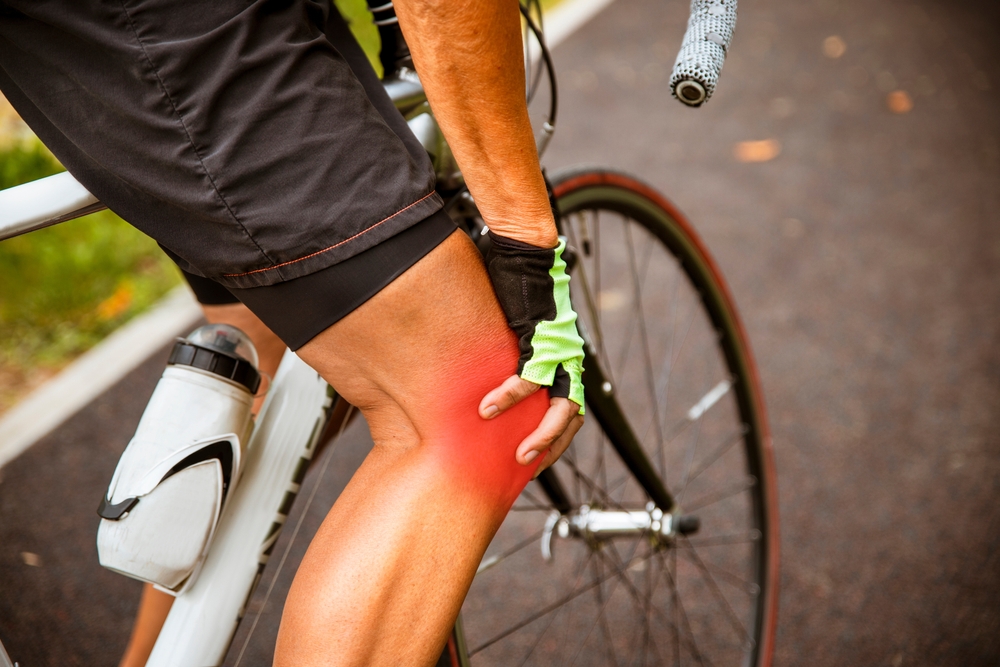What Causes Knee Pain While Cycling?
Cycling knee pain can develop for various reasons, and understanding the root cause is the first step toward effective treatment and prevention. Here are some of the most common types of cycling knee pain:
1. Anterior Knee Pain:
Often experienced at the front of the knee and around the kneecap, this pain is frequently due to increasing your mileage too quickly without adequate training. It’s especially common when cyclists ramp up their activity after a period of rest, such as in the spring after a winter break.
2. Posterior Knee Pain:
Pain behind the knee is often a result of overextending the knee due to an improper seat position. If your seat is too high, it can cause excessive strain on the back of the knee.
3. Medial and Lateral Knee Pain:
Pain on the sides of the knee is usually related to improper bike setup, particularly the positioning of the pedal cleats. Incorrect alignment can lead to unnecessary strain on the knee ligaments and tendons.
4. Iliotibial Band Syndrome (ITBS):
This painful condition arises from inflammation in the iliotibial band, a fibrous tissue that runs from your hip to your shin. ITBS is often caused by improper bike fit, including saddle height and foot positioning.
Treatments for Cycling Knee Pain
Addressing cycling knee pain early can prevent more severe injuries and help you get back to enjoying your rides. Here are some effective treatment strategies:
1. Rest and Recovery:
The most common form of cycling knee pain, anterior knee pain, often requires rest. Taking a break from cycling allows your body to heal and reduces inflammation.
2. Adjust Your Bike Setup:
Proper bike fit is essential to prevent and alleviate knee pain. Ensure your saddle is at the correct height and position to avoid overextending your knee. Additionally, check the alignment of your pedal cleats to ensure your feet are properly positioned.

3. Strengthen Key Muscles:
Working with a physical therapist can help you strengthen the vastus medialis oblique (VMO) muscle, which plays a critical role in stabilizing the kneecap. Strengthening this muscle can reduce the risk of knee pain and improve your overall cycling performance.
4. Stretching and Massage:
Incorporating regular stretching and massage into your routine can help alleviate tightness and improve flexibility, reducing the likelihood of knee pain.
How to Prevent Cycling Knee Pain
Prevention is key when it comes to cycling knee pain. Here are some strategies to keep in mind:
1. Choose the Right Bike Fit:
Investing in a bike that fits your body properly is essential. Ensure your saddle is at the correct height and position, and consider professional bike fitting services if needed.
2. Wear the Right Gear:
Proper cycling gear, including well-fitted shoes and cleats, can significantly reduce strain on your knees. Look for moisture-wicking clothing to keep you comfortable and dry during long rides.
3. Gradually Increase Your Mileage:
Avoid ramping up your cycling mileage too quickly. Gradual increases in distance and intensity allow your body to adapt and reduce the risk of knee pain.
4. Work with a Physical Therapist:
A physical therapist can help you develop a personalized plan to strengthen your muscles, improve your bike fit, and prevent knee pain. Regular check-ins with a therapist can ensure you’re staying on track with your cycling goals.
When to Seek Medical Attention
If you experience persistent knee pain that limits your ability to cycle or perform daily activities, it’s important to seek medical attention. A physical therapist can help diagnose the underlying cause of your knee pain and create a tailored treatment plan.
At Rock Valley Physical Therapy, we’re here to help you overcome cycling knee pain and get back to doing what you love. Whether you’re dealing with acute pain or want to improve your cycling performance, our team is ready to support you every step of the way.
Cycling discomfort? Book a session with Rock Valley PT and get back on track!
Find a local clinic near you to start your journey toward pain-free cycling.
